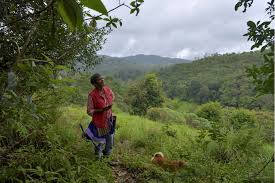Conserving the Western Ghats

- 03 Jul 2025
Context:
The Western Ghats, a UNESCO World Heritage Site and one of the world’s eight hottest biodiversity hotspots, stretch across six Indian states—Gujarat, Maharashtra, Goa, Karnataka, Kerala, and Tamil Nadu. Rich in endemic flora and fauna, they play a critical role in influencing the Indian monsoon, regulating climate, and sustaining major river systems like the Godavari, Krishna, and Kaveri. However, this ecologically sensitive region faces growing environmental and governance challenges.
Renowned ecologist Madhav Gadgil has strongly advocated for a community-led conservation model, citing the failures of top-down forest bureaucracy and the neglect of the Forest Rights Act (FRA), 2006. He argues that without empowering local communities, conservation efforts will remain ineffective.
Geological and Ecological Background
The Western Ghats are ancient, formed through Precambrian cratonic uplift and Deccan Traps volcanism over 600 million years ago. The western edge of the Deccan Plateau subsided post-Gondwana breakup, forming the escarpments we see today. Over time, monsoon-fed rivers carved deep valleys, resulting in the current terrain of lateritic plateaus and ridges.
With over 7,400 species—many of them endemic—the region is home to unique ecosystems. Yet, despite its ecological importance, conservation has suffered due to flawed governance, industrial exploitation, and neglect of community rights.
Challenges in Western Ghats Conservation
- Flawed Forest Governance:Government agencies often rely on outdated and inflated forest data. For instance, Gadgil's 1975 study in Uttara Kannada revealed bamboo stocks were overestimated tenfold to justify resource extraction.
- Industrial Pollution:Unregulated industries operate in fragile zones. The Grasim Rayon Factory in Kerala discharged mercury into the Chaliyar River, decimating fisheries and affecting tribal livelihoods.
- Non-implementation of FRA (2006):Despite legal entitlements, Community Forest Rights (CFR) remain unimplemented in most districts, particularly in Kerala and Karnataka.
- Monoculture Plantations:Replacement of native forests with eucalyptus and acacia has led to biodiversity loss, declining soil health, and reduced pollinator populations, as seen in Wayanad.
- Forest Fires from Unsustainable Practices:Fire-based tendu leaf collection methods degrade forest cover. For instance, Gadchiroli and Karnataka have witnessed increased fire incidents.
- Inaccessible Ecological Data:Forest data remains aggregated and delayed. Studies using NRSC and Global Forest Watch have exposed discrepancies in official forest cover claims.
Committee Recommendations
- WGEEP (2011), led by Gadgil, advocated for Ecologically Sensitive Area (ESA) zoning, Gram Sabha-led conservation, and strict implementation of CFR.
- The Kasturirangan Committee (2013) diluted these recommendations by reducing ESA coverage and favouring development-centric governance.
Way Forward
- Implement CFR Provisions: E.g., Pachgaon in Maharashtra demonstrates how CFR-based governance can lead to sustainable bamboo harvesting and fire prevention.
- Promote Democratic Decentralisation: Empowering Gram Sabhas, as in Kerala’s VSS model, ensures accountability and local participation.
- Modernise Ecological Monitoring: Tools like Google Earth and Bhuvan offer real-time forest tracking, countering manipulated datasets.
- Ban Unsustainable Industries in ESA: SC orders on mining bans in wildlife corridors must be enforced, especially in states like Goa and Kerala.
- Support Biodiversity-Friendly Livelihoods: NTFP-based enterprises, eco-tourism, and agroforestry, like Wayanad tribal co-operatives selling organic turmeric and wild honey, can align conservation with income.
Conclusion
The Western Ghats are central to India’s ecological, hydrological, and cultural stability. Conservation rooted in community empowerment, transparent governance, and ecological integrity is essential. Only a democratic, decentralized, and data-driven model, as envisioned by Gadgil, can secure the future of this ecological treasure.
